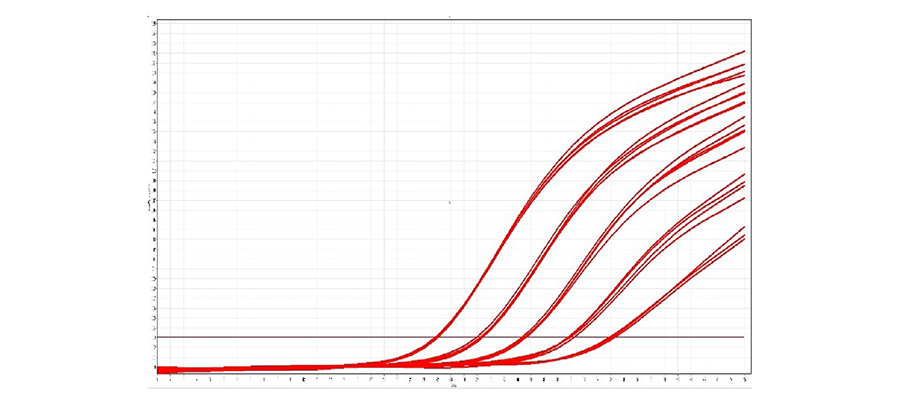Hi-throughput dUTP qPCR Mix Master Mix
Hi-throughput dUTP qPCR Mix is fast, highly reproducible real-time PCR master mix that has been designed with a highly optimized buffer chemistry and hot-start DNA polymerase, to deliver excellent results and very low background, allowing greater sensitivity.
Have questions about a product?
Meridian's Lyo-Ready Hi-throughput dUTP qPCR Mix Master Mix
- Optimized dTTP to dUTP ratio for high sensitivity and specificity.
- High efficiency, giving excellent performance in multiplex qPCR assays.
- Prevents carry-over qPCR contamination.
High efficiency and sensitivity with DNA viruses

Amplification of a 10-fold serial dilution of Parvovirus B19 from inactivated crude viral lysates was tested using Hi-throughput dUTP qPCR Mix and primers and probe for Parvovirus B19. Four replicated are shown in the amplification curve, illustrate the reproducibility, efficiency and sensitivity of Hi-throughput dUTP qPCR Mix.
Hi-throughput dUTP qPCR Mix, MDX031
qPCR mix containing Taq polymerase, reaction buffer, dNTP/dUTP mix and MgCl2, developed to remove background PCR product contamination.
Documents & Resources
Description
Hi-throughput dUTP qPCR Mix contains Taq DNA polymerase, reaction buffer, dNTP, MgCl2, stabilizers and PCR enhancers. However, some of the dTTPs in the dNTP mix has been substituted for dUTP, so that Uracil DNA Glycosylase (UDGase) (MDX054) can be added to carry-over qPCR contamination. This makes Hi-throughput dUTP qPCR ideal for multiplex assays on open, automated, high-throughput instruments.
Specifications
| Description | qPCR mix containing Taq polymerase, reaction buffer, dNTP/dUTP mix and MgCl2, developed to remove background PCR product contamination. |
| Concentration | 2 x |
| Appearance | Clear, colorless solution |
| Hot Start | Antibody mediated |
| Application | High throughput qPCR |
| Sample type | cDNA, DNA |
| Presentation | 1 vial |
| Storage | -20 °C |
| Mix stability | See outer label |
| Consistency | ± 0.5 Ct variance between test and reference sample |
| DNase/RNase Contamination | None detected in PCR amplification with traces overlay with the negative control on E. coli and mouse genomic DNA specific targets. |
| DNase Contamination | No detectable degradation |
Catalogs & Brochures
FAQs: Hi-throughput dUTP qPCR Mix
What is carryover qPCR contamination?
As qPCR can amplify tiny amounts of DNA, preventing contamination is essential, as even small amounts of qPCR contamination can produce false positives. Cross-over qPCR contamination can include cross-contamination from other samples, contamination from elsewhere in the laboratory, and carryover qPCR contamination from amplification products and primers used in prior qPCR experiments. The latter causes most of the false positive results seen in qPCR. Preventing contamination can be difficult and so laboratory procedures must be in place to ensure DNA from one assay is not re-amplified in subsequent assay.
How is Uracil DNA Glycosylase used in qPCR?
Uracil DNA Glycosylase can specifically degrade products that have already been through the qPCR process and have incorporated dUTP, leaving native nucleic acid templates intended for amplification intact. Uracil DNA Glycosylase activation occurs as the first step of qPCR at a 50°C incubation for 2 minutes and then the Uracil DNA Glycosylase is denatured when the temperature increases to 95°C during hot-start activation.
What is the difference between UDG and UNG?
Uracil-DNA glycosylase (UDG or UDGase) is a family of enzymes comprising six sub-families. Family I UDGase enzymes are called UNG (uracil-N-glycosylase gene), so there is no difference, the terms UDG and UNG are commonly used interchangeably because they perform the same function in qPCR—namely to prevent carryover qPCR contamination.
Why is dUTP not used for all qPCR assays?
Total elimination of contaminants is not always accomplished using this technique, particularly where PCR product length is short, which is a common situation in qPCR assays. In addition, there is the possibility, particularly when the initial sample contains only one or a few target molecules, that inclusion of UDG may reduce amplification efficiency and thereby delay detection and so reduce sensitivity.
Get In Touch With A Specialist
Have questions about a product? Want to learn more about Meridian’s molecular or immunoassay reagent portfolio? We want to hear from you!
By submitting your information in this form, you agree that your personal information may be stored and processed in any country where we have facilities or service providers, and by using our “Contact Us” page you agree to the transfer of information to countries outside of your country of residence, including to the United States, which may provide for different data protection rules than in your country. The information you submit will be governed by our Privacy Statement.